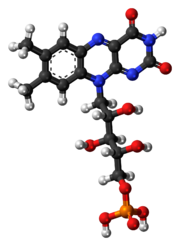This is the current revision of this page, as edited by Citation bot (talk | contribs) at 16:13, 9 December 2024 (Alter: first2, last5, last7, last21, last28. | Use this bot. Report bugs. | Suggested by Dominic3203 | Linked from User:Marbletan/sandbox | #UCB_webform_linked 258/2664). The present address (URL) is a permanent link to this version.
Revision as of 16:13, 9 December 2024 by Citation bot (talk | contribs) (Alter: first2, last5, last7, last21, last28. | Use this bot. Report bugs. | Suggested by Dominic3203 | Linked from User:Marbletan/sandbox | #UCB_webform_linked 258/2664)(diff) ← Previous revision | Latest revision (diff) | Newer revision → (diff) | |
 | |
| Names | |
|---|---|
| IUPAC name 1-Deoxy-1-(7,8-dimethyl-2,4-dioxo-3,4-dihydrobenzopteridin-10(2H)-yl)-D-ribitol 5-(dihydrogen phosphate) | |
| Systematic IUPAC name (2R,3S,4S)-5-(7,8-Dimethyl-2,4-dioxo-3,4-dihydrobenzopteridin-10(2H)-yl)-2,3,4-trihydroxypentyl dihydrogen phosphate | |
Other names
| |
| Identifiers | |
| CAS Number | |
| 3D model (JSmol) | |
| ChEBI | |
| ChEMBL | |
| ChemSpider | |
| ECHA InfoCard | 100.005.150 |
| E number | E101a (colours) |
| IUPHAR/BPS | |
| MeSH | Flavin+mononucleotide |
| PubChem CID | |
| UNII | |
| CompTox Dashboard (EPA) | |
InChI
| |
SMILES
| |
| Properties | |
| Chemical formula | C17H21N4O9P |
| Molar mass | 456.344 g/mol |
| Melting point | 195 °C |
| Except where otherwise noted, data are given for materials in their standard state (at 25 °C , 100 kPa).
| |
| This article needs additional citations for verification. Please help improve this article by adding citations to reliable sources. Unsourced material may be challenged and removed. Find sources: "Flavin mononucleotide" – news · newspapers · books · scholar · JSTOR (December 2009) (Learn how and when to remove this message) |
Flavin mononucleotide (FMN), or riboflavin-5′-phosphate, is a biomolecule produced from riboflavin (vitamin B2) by the enzyme riboflavin kinase and functions as the prosthetic group of various oxidoreductases, including NADH dehydrogenase, as well as a cofactor in biological blue-light photo receptors. During the catalytic cycle, a reversible interconversion of the oxidized (FMN), semiquinone (FMNH), and reduced (FMNH2) forms occurs in the various oxidoreductases. FMN is a stronger oxidizing agent than NAD and is particularly useful because it can take part in both one- and two-electron transfers. In its role as blue-light photo receptor, (oxidized) FMN stands out from the 'conventional' photo receptors as the signaling state and not an E/Z isomerization.
It is the principal form in which riboflavin is found in cells and tissues. It requires more energy to produce, but is more soluble than riboflavin. In cells, FMN occurs freely circulating but also in several covalently bound forms. Covalently or non-covalently bound FMN is a cofactor of many enzymes playing an important pathophysiological role in cellular metabolism. For example dissociation of flavin mononucleotide from mitochondrial complex I has been shown to occur during ischemia/reperfusion brain injury during stroke.
Food additive
Flavin mononucleotide is also used as an orange-red food colour additive, designated in Europe as E number E101a.
E106, a very closely related food dye, is riboflavin-5′-phosphate sodium salt, which consists mainly of the monosodium salt of the 5′-monophosphate ester of riboflavin. It is rapidly turned to free riboflavin after ingestion. It is found in many foods for babies and young children as well as jams, milk products, and sweets and sugar products.
See also
References
- Tsibris, John C. M.; McCormick, Donald B.; Wright, Lemuel D. (1966). "Studies on the Binding and Function of Flavin Phosphates with Flavin Mononucleotide-dependent Enzymes". Journal of Biological Chemistry. 241 (5): 1138–43. doi:10.1016/S0021-9258(18)96813-4. PMID 4379862.
- Mewies M, McIntire WS, Scrutton NS (1998). "Covalent attachment of flavin adenine dinucleotide (FAD) and flavin mononucleotide (FMN) to enzymes: The current state of affairs". Protein Science. 7 (1): 7–20. doi:10.1002/pro.5560070102. PMC 2143808. PMID 9514256.
- Kahl, A; Stepanova, A; Konrad, C; Anderson, C; Manfredi, G; Zhou, P; Iadecola, C; Galkin, A (2018). "Critical Role of Flavin and Glutathione in Complex I-Mediated Bioenergetic Failure in Brain Ischemia/Reperfusion Injury". Stroke. 49 (5): 1223–1231. doi:10.1161/STROKEAHA.117.019687. PMC 5916474. PMID 29643256.
- Galkin, A (2019). "Brain Ischemia/Reperfusion Injury and Mitochondrial Complex I Damage". Biochemistry. Biokhimiia. 84 (11): 1411–1423. doi:10.1134/S0006297919110154. PMID 31760927. S2CID 207990089.
- "Current EU approved additives and their E Numbers", Food Standards Agency website, retrieved 15 Dec 2011
- Turck, Dominique; Bresson, Jean-Louis; Burlingame, Barbara; et al. (2017). "Dietary Reference Values for riboflavin". EFSA Journal. 15 (8): e04919. doi:10.2903/j.efsa.2017.4919. PMC 7010026. PMID 32625611.
External links
| Enzyme cofactors | |||||||
|---|---|---|---|---|---|---|---|
| Active forms |
| ||||||
| Base forms | |||||||